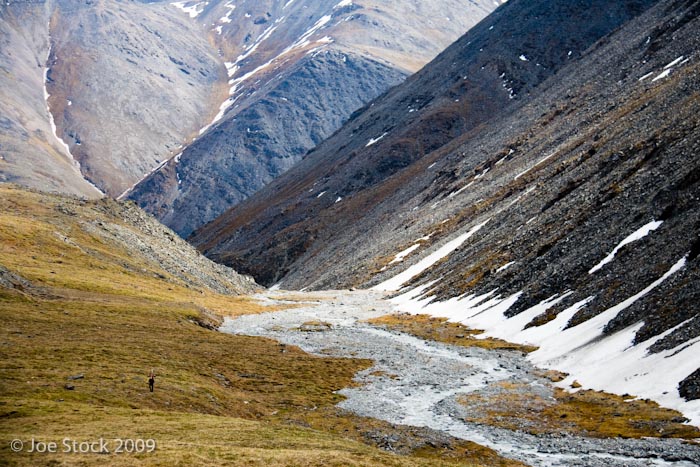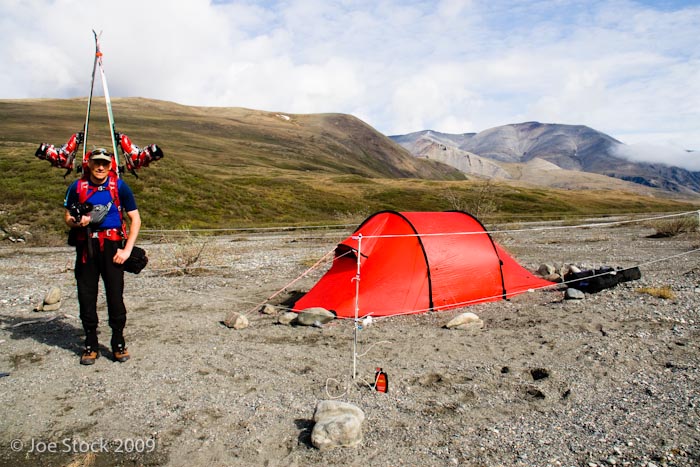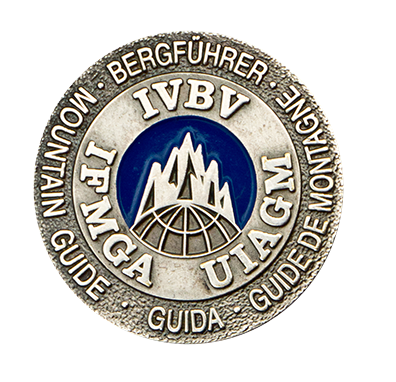In June 2009 photographer Matt Hage and I skied from the summit of 9,020-foot Mount Chamberlin in the Arctic National Wildlife Refuge. Chamberlin is the highest summit in Brooks Range according to the most recent maps.

The Brooks Range has the worst snow in North America. Minus fifty-degree winter temperatures change the measly arctic snowpack into knee-deep depth hoar. In spring, it becomes knee-deep isothermal slop. These conditions have kept rational skiers away, leaving a void in the annals of Brooks Range ski descents.
The Brooks Range stretches 550 miles across northern Alaska, from the Chukchi Sea to the Canadian border. Within the Arctic National Wildlife Refuge, at the east end of the range lies Mount Chamberlin. At 9,020 feet, Chamberlin is currently considered the highest mountain in the Arctic outside of Greenland. The idea of skiing Mount Chamberlin was not rational, just an excuse for a adventure. I knew only an Alaskan would be game for a trip with guaranteed bad snow, mosquitoes, bears and almost no route information. The résumé of Anchorage photographer Matt Hage boasts a healthy list of bit Alaska trips—and he had guns. We’d never been on a big trip together and we’d never been in the Brooks Range.

In early June 2009 Shawn Shoultyss of Wright Air landed us on a gravel bar along the Hulahula River. The Hulahula is named by whalers nostalgic for Hawaii in the nineteenth century. This would be our base camp for the next 12 days. Not too far away, in 2005, the Hulahula became national news when a rogue grizzly ate two kayakers. To avoid becoming bear fodder, Matt and I brought pepper spray, bear-proof food canisters, a battery-powered electric fence, a twelve-gauge shotgun and a .44 handgun. I’d never shot a gun. I hoped Matt had good aim at charging bears. I also hoped I could run faster than Matt.

When the bushplane’s drone became a distant buzz, we cracked a round of Modelo’s and examined our situation. We were 7,500 feet below the summit of Chamberlin and 13 miles from its base. We were also on the opposite side the mountain than our plan due flooded landing strips. We also saw no snow. For two days Matt and I lugged our ski gear up Katak Creek. Three times we saw grizzlies running from us across the tundra and began to feel okay about leaving the guns at base camp. Under blue skies, we established high camp at 5,000-feet in the green tundra below the summit pyramid of Mount Chamberlin. Then the fog rolled in.

Next morning, crouching in our micro tent, we nibbled at our meager supplies as a thick mixture of snow and rain saturated the tent. I fumed with annoying repetition, “Maybe we should go for it. Maybe we’ll climb above it.” But fog and rain mean a negative budget to a photographer. If Matt knew me better, he would have told me to “calm-the-fuck-down,” like friends on previous expeditions have done a thousand times. Matt just looked at me wide-eyed and smiled nervously. When the bad weather won, we descended to the Hulahula base camp for more groceries and returned to continue watching the clouds and the barometer.
The fog cracked on the seventh morning. I bolted from the tent like an unleashed sled dog and headed toward the east ridge. When I realized Matt was far behind, I paced in circles and studied the map until he caught up. Where our 1958 map showed glacier, we skinned up a moraine-filled basin through broken clouds and emerged on the boulder-covered east ridge at 7,000 feet. We scrambled through the snow-coated boulders, kicked steps up a 45-degree snow face, and reached the summit ridge above the Chamberlin Glacier. The recent storm had created thin bridges over the crevasses. When my foot punched through the roof of a crevasse into a cavern of glittering crystals, we tied ourselves together thirty feet apart with a five-millimeter Dyneema rope and continued kicking steps up the twisting snow arête to the summit of the Brooks Range.

Standing on the summit of the most remote high point in North America probably should’ve brewed more sentiment, but all peaks in Alaska are remote. We saw mountains in all directions, a blanket of fog covering the Arctic coastal plain to the north, and no sign of humans. What I did feel was the crushing weight of eight months of planning and uncertainty begin to lift. Matt, who had been more optimistic about the outcome of this trip than I, saw my mood improve and we laughed together. Maybe we should have center-punched the Chamberlin Glacier, Jeremy Nobis-style, ripping turns between the gaping crevasses and skimming the saggers, taking the proud line. But we knew the inglorious reality. Rescue was laughable. We needed a huge margin of safety.

We clicked into our skis—me on AT, Matt on tele—relieved to have them off our backs—and made unroped, controlled turns on the 40-degree snow-coated glacier ice crest of the Chamberlin Glacier. The other side of the crest was a corniced wall dropping near vertical to a distant valley. The snow was fun and easy despite the light being flat enough to give a cat vertigo. Past the last crevasse, we opened our turns up, carving fast sweepers on hero corn. A thousand feet above camp, the snow deteriorated into the Brooks Range’s notorious isothermal slop and we sunk thigh-deep midway through each turn. Eventually we gave up, shouldered our skis and stumbled down loose moraine to camp.
For three more days, Matt and I camped at 5,000 feet, venturing into the midnight sun to make corn runs at 7,000 feet before the daily build-up of clouds. On our second to last day before our scheduled pickup, we packed up camp and trudged the 13 miles back out to the Hulahula landing strip to wait for Wright Air.

If you ran the calculations, you’d find skiing Mount Chamberlin contrived—we carried our skis and boots more than we wore them. But the question is: would we have gone to Chamberlin without skis? If we’d summitted Chamberlin without them, surely we’d have said, “WHY didn’t we bring our skis?!” We did bring skis, though, and they were so worth it. Skiing gave us a reason for a crazy, irrational adventure, and those summit turns were world class.
Matt and I sat in the gravel by the Hulahula, waiting and drinking Early Times. “You ever shot a 12-gauge bear slug?” he asks.
“No, I’ve never shot a gun,” I say.
Matt hands me the gun. “Keep it against your shoulder. “Have an athletic stance. It will kick.”
Thanks To:
To the Hans Fund crew for knowing that ski mountaineering is a higher form of alpinism.
To the folks at Osprey Packs for making incredible gear. We used Variant 52 for the best combination of heavy load hauling and light summit packs. For travel we used Transporter 95—only 2 pounds 5 ounces. Keep up the great work!

